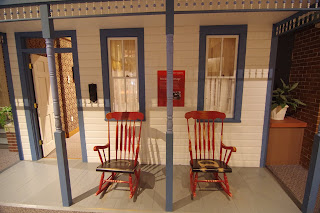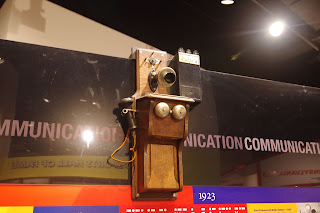July 18-The
Durham Museum, Omaha, NE
The Durham
Museum is housed in the former Omaha Union Station that saw its last passenger
in 1971.

The exhibits
include thousands of objects related to the history of Omaha and the
surrounding region.
The Union
Station, opened in 1931, included just about every amenity a passenger could
want; a 24-hour restaurant, news and magazine stand, barbershop, taxi stand,
telegraph office, hospital, and traveler’s aid office.
During WWII,
American servicemen traveled through Omaha by train.
The
construction of highways and interstates replaced trains as the preferred means
of long distance travel leading to the closing of the station.
Today, the
station recalls a bygone era of the history.
The Station’s
main waiting room is on the Upper Level.
This is where travelers purchased tickets, checked their baggage and
waited for trains to arrive.
The Statues
in the main hall were crafted by John Labja, an Omaha sculptor. The symbolize people who would have passed
through Union Station.
The soda
fountain buzzed with activity during the station’s busy years.

Tobacco products once lined the counter where
the candy is today.

I ordered an egg
cream

while Monte ordered a butterscotch malt.
Both were delicious.
The Barigth
Home and Family Gallery, located on the lower level, shows how families lived
in Omaha in the 1800s through the 1950s.
The Model A Ford-manufactured from 1927-1931
The 1932 Douglas Truck-This Omaha motor company focused
on building sturdy trucks for hauling livestock.
Wells Fargo Mud Wagon (c.1870) Muddy and snow covered winter roads stopped heavy stage coaches, but not the lighter mud wagon. These wagons carried goods, letters and passengers to their destinations.
From 1846-1869, more than 70,000 Mormons traveled 1,300 miles to their new homeland near the Great Salt Lake in Utah Territory in this type of wagon.
The Mutual
of Omaha Theater has a film presentation showing the development of Omaha from
the mid 1800s to today.
The Buffett
Grocery Store is an exhibit featuring a replica storefront of the original that
opened in 1915.

The Bekins
Van & Storage Company exhibit explores the history of an early Omaha family-based
business.
The steam
locomotive stations demonstrate some of the technologies steam engines used to
help the railroad expand westward.
The Harriman
Family Line train car contains the Pullman car, lounge car and caboose.
 The American
Adventure experience reveals the reality of what the settlers faced and how
everyday decisions could be a matter of life and death.
The American
Adventure experience reveals the reality of what the settlers faced and how
everyday decisions could be a matter of life and death.
One of the
interactive current exhibits featured at the museum is the American Adventure
testing if you have what it takes to survive.
Settlers
landed on the shores of Virginia in 1607 creating the first permanent European
settlement. One year later only 38 of
the 104 settlers were still alive.
Visitors
choose a unique identity of one of the Jamestown colonists and track a series
of life choices on a abacus representing life points for health, wealth, food
and morale.
Survival is
based on visitor knowledge and ingenuity. The American
Adventure experience reveals the reality of what the settlers faced and how
everyday decisions could be a matter of life and death.
The American
Adventure experience reveals the reality of what the settlers faced and how
everyday decisions could be a matter of life and death.
Monte
survived.
I did not.














































No comments:
Post a Comment